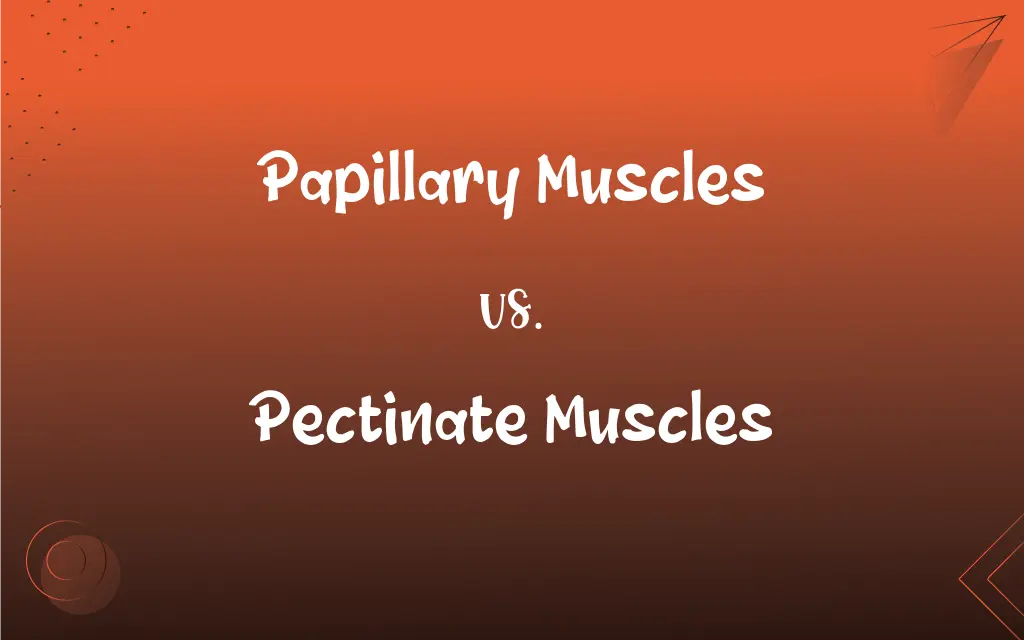Papillary Muscles vs. Pectinate Muscles: What's the Difference?
Edited by Aimie Carlson || By Janet White || Published on January 14, 2024
Papillary muscles, located in the ventricles of the heart, anchor heart valves; pectinate muscles, found in the atria, aid in contraction.

Key Differences
Papillary muscles are located in the ventricles of the heart and play a crucial role in the function of the heart valves. They attach to the valves via chordae tendineae. Pectinate muscles, on the other hand, are found in the atrial walls, predominantly in the right atrium, and are involved in the contraction of the atria.
The structure of papillary muscles is such that they support the mitral and tricuspid valves, preventing valve prolapse into the atria during ventricular contraction. Pectinate muscles, conversely, have a comb-like appearance and contribute to the forceful contraction of the atria, aiding in effective blood flow.
Papillary muscles receive their blood supply from the coronary arteries, which is critical for their function in the valve mechanism. Pectinate muscles are less dependent on such a direct blood supply and are more involved in the electrical conduction system of the heart.
In terms of clinical significance, damage to the papillary muscles, such as in a heart attack, can lead to mitral valve regurgitation. Pectinate muscles are less commonly associated with specific heart diseases, but their structure can be involved in the formation of atrial arrhythmias.
In terms of embryological development, papillary muscles develop as part of the ventricular myocardium. Pectinate muscles, in contrast, form from the primitive atrial muscle, reflecting their distinct roles in the heart's anatomy and function.
ADVERTISEMENT
Comparison Chart
Location
Ventricles of the heart
Atria of the heart
Function
Anchor heart valves
Aid in atrial contraction
Appearance
Finger-like projections
Comb-like structure
Association with heart valves
Direct (via chordae tendineae)
Indirect
Clinical significance
Valve prolapse, regurgitation
Atrial arrhythmias
ADVERTISEMENT
Papillary Muscles and Pectinate Muscles Definitions
Papillary Muscles
These muscles are crucial for the efficient operation of the mitral and tricuspid valves.
The patient's heart condition was attributed to damaged papillary muscles.
Pectinate Muscles
These muscles contribute to the forceful contraction of the atria.
In atrial fibrillation, the pectinate muscles' rhythm becomes irregular.
Papillary Muscles
Papillary muscles are muscular projections in the heart's ventricles that support the atrioventricular valves.
During a heart surgery, the surgeon carefully preserved the integrity of the papillary muscles.
Pectinate Muscles
Pectinate muscles play a role in the heart's electrical conduction system.
Abnormalities in the pectinate muscles can contribute to certain types of heart arrhythmias.
Papillary Muscles
Papillary muscles contract during ventricular systole to maintain valve closure.
A malfunction in the papillary muscles can lead to mitral valve regurgitation.
Pectinate Muscles
Pectinate muscles are ridged muscles located in the walls of the atria of the heart.
The doctor explained how the pectinate muscles assist in the heart's pumping action.
Papillary Muscles
These muscles attach to the valves via chordae tendineae to prevent prolapse.
An echocardiogram can show the movement of papillary muscles during the cardiac cycle.
Pectinate Muscles
Pectinate muscles are more prominent in the right atrium than in the left.
A cardiac MRI revealed the detailed structure of the pectinate muscles.
Papillary Muscles
They play a key role in the heart's mechanical functioning.
Cardiologists often assess the health of papillary muscles to evaluate valve function.
Pectinate Muscles
They have a comb-like appearance and are part of the atrial myocardium.
The pectinate muscles' unique structure was clearly visible in the anatomical model.
FAQs
Where are papillary muscles located?
Inside the ventricles of the heart.
What function do pectinate muscles serve?
They assist in atrial contraction and are part of the heart's electrical system.
How do pectinate muscles appear?
They have a distinctive comb-like structure.
How do papillary muscles contribute to heart health?
By ensuring efficient valve function during the cardiac cycle.
What are papillary muscles?
Muscular projections in the heart's ventricles supporting atrioventricular valves.
Do pectinate muscles vary in size or shape among individuals?
Yes, there can be variations in their structure.
How are papillary muscles attached to heart valves?
Via chordae tendineae.
Are pectinate muscles present in both atria?
Yes, but more prominent in the right atrium.
What is the clinical significance of damaged papillary muscles?
Can lead to valve prolapse and regurgitation.
Can pectinate muscles be involved in heart diseases?
Yes, primarily in atrial arrhythmias.
Are pectinate muscles visible in standard heart imaging tests?
They can be seen in detailed imaging like MRI or echocardiography.
Do pectinate muscles have a role in the heart's blood flow?
Indirectly, by aiding atrial contraction.
Is exercise beneficial for the health of papillary muscles?
Indirectly, as overall heart health improves with exercise.
Are pectinate muscles unique to humans?
No, they are found in the hearts of many mammals.
Can papillary muscles regenerate after damage?
Regeneration is limited; damage often requires medical intervention.
Can you live without papillary muscles?
They are essential for heart function; damage requires medical attention.
Do pectinate muscles respond to electrical stimulation?
Yes, as they are part of the atrial conduction system.
What happens if papillary muscles malfunction?
It can result in heart valve issues and reduced cardiac efficiency.
Do pectinate muscles grow larger with exercise?
Not significantly, as their role is more electrical than mechanical.
How are papillary muscles studied in medical research?
Through cardiac imaging, dissection, and advanced simulation models.
About Author
Written by
Janet WhiteJanet White has been an esteemed writer and blogger for Difference Wiki. Holding a Master's degree in Science and Medical Journalism from the prestigious Boston University, she has consistently demonstrated her expertise and passion for her field. When she's not immersed in her work, Janet relishes her time exercising, delving into a good book, and cherishing moments with friends and family.
Edited by
Aimie CarlsonAimie Carlson, holding a master's degree in English literature, is a fervent English language enthusiast. She lends her writing talents to Difference Wiki, a prominent website that specializes in comparisons, offering readers insightful analyses that both captivate and inform.






































































